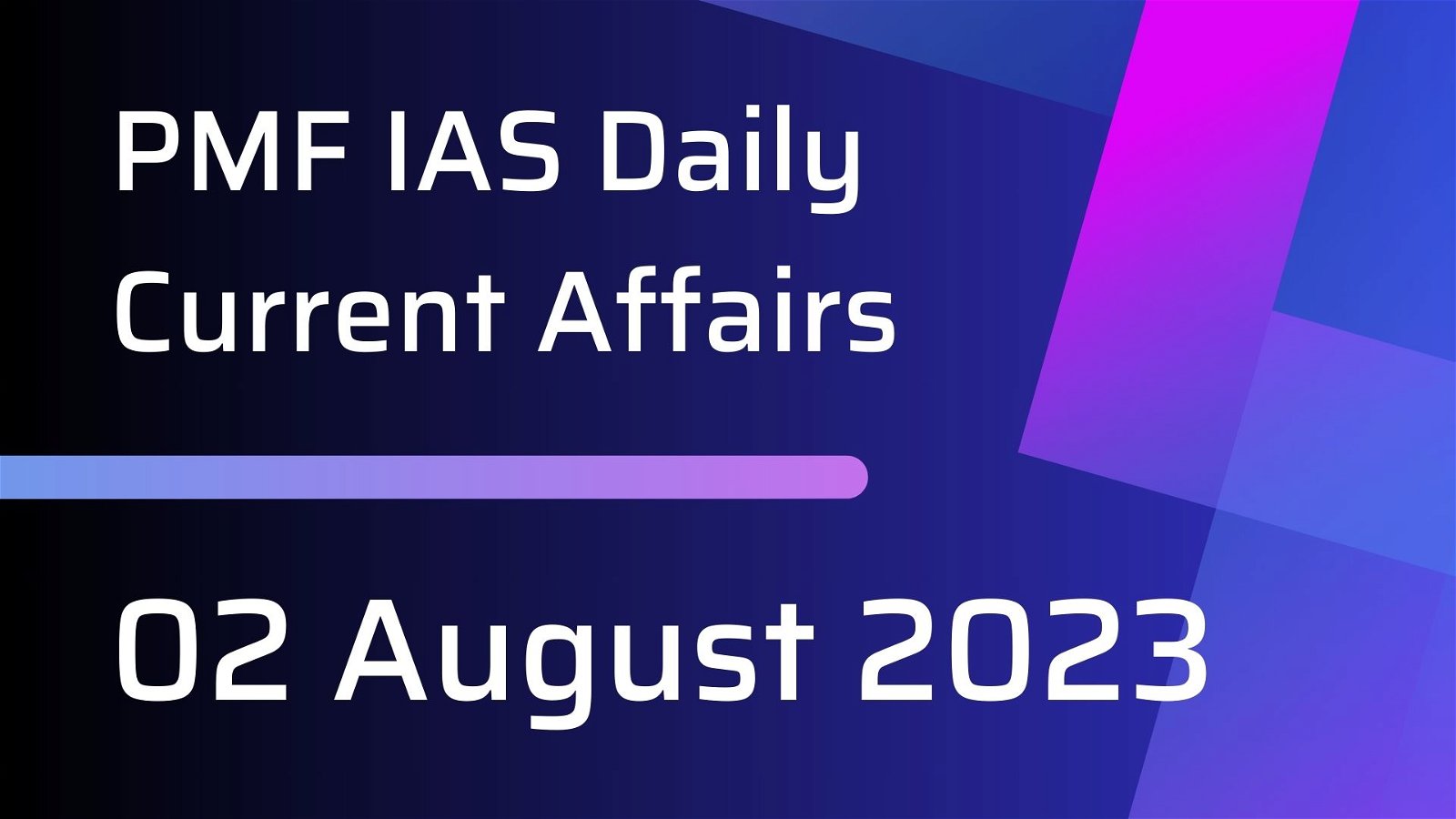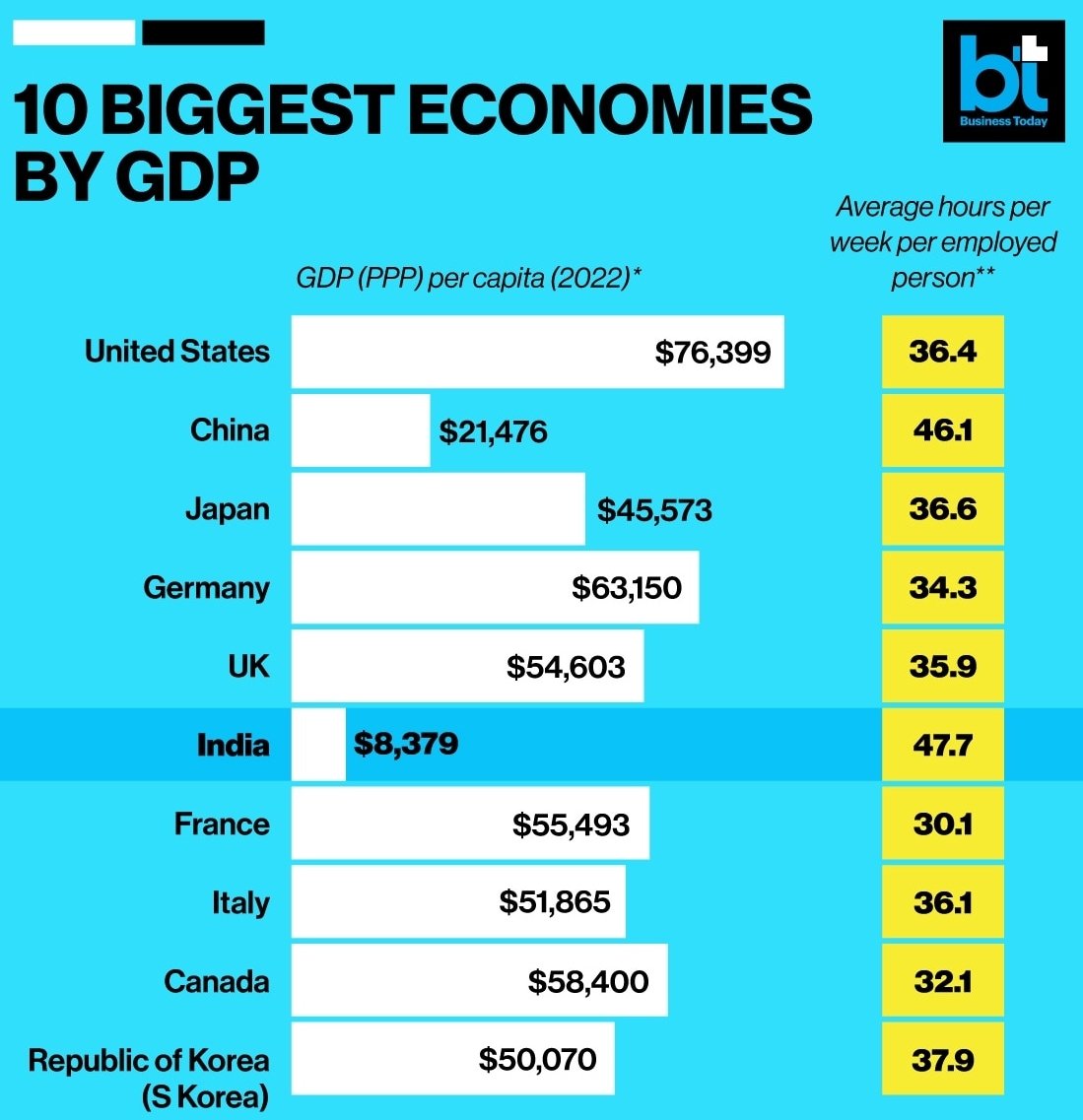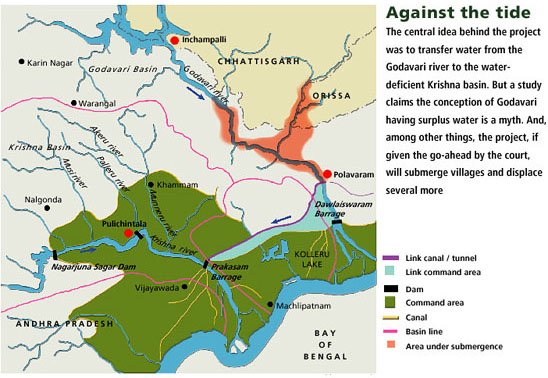
Current Affairs August 31, 2023: TLD Pill, HIV, India’s Call for Modification of Indus Water Treaty, Gig Workers Bill. SWAMIH, NSKFDC, NGT, BRO, Amitabh Kant Committee on Real Estates, Gabon, Spamouflage
Subscribers of "Current Affairs" course can Download Daily Current Affairs in PDF/DOC
Subscribe to Never Miss an Important Update! Assured Discounts on New Products!
Must Join PMF IAS Telegram Channel & PMF IAS History Telegram Channel
{GS2 – Health – Initiative – 2023/08/31} TLD Pill
- Context (TH): The Global Fund signed a deal with generic pharmaceutical manufacturers to slash the price of an HIV drug called TLD Pill.
TLD Pill
- TLD bands together the drugs tenofovir disoproxil fumarate, lamivudine, and dolutegravir.
- WHO has recommended TLD as the preferred first-line HIV treatment for adults and adolescents.
- It rapidly suppresses the virus that causes AIDS.
Global Fund
- Global is a worldwide movement to defeat HIV, TB, and malaria established in 2002.
- It is a partnership of governments, civil society, technical agencies, private sector, and people affected by the diseases.
- It pools resources to invest in programs to end AIDS, TB, and malaria as public health threats.
Impact
- The Global Fund provides 30% of all international financing for HIV programs.
- In countries where the Global Fund invests, AIDS-related deaths have been reduced by 70%.
Human immunodeficiency virus (HIV)
- HIV is an infection that attacks the body’s immune system.
- Acquired immunodeficiency syndrome (AIDS) is the most advanced stage of HIV.
- HIV targets the body’s white blood cells, weakening the immune system.
- This makes it easier to get sick with diseases like tuberculosis, infections, and some cancers.

HIV structure
- It consists of two identical single-stranded RNA molecules enclosed within the core of the virus.
- It is similar in structure to other retroviruses.
Transmission
- HIV can be transmitted via the exchange of a variety of body fluids from people living with HIV, such as blood, breast milk, semen, and vaginal secretions.
- It can also be transmitted during pregnancy and delivery of the child.
- People cannot become infected through ordinary day-to-day contact such as kissing, hugging, shaking hands, or sharing personal objects, food, or water.
Treatment
- There is no cure for HIV infection.
- Patients are given antiretroviral therapy (ART), which stops the virus from replicating in the body.
- ART allows a person’s immune system to get stronger and helps them to fight other infections.
{GS2 – IR – India-Pakistan – 2023/08/31} Contention on Indus Water Treaty
- Context (TH | TH | TH | IE | IE | TH | TH): The Indus Waters Treaty (IWT), brokered by the World Bank, has again become a source of contention between India and Pakistan.
Indus River System (GS1, Geo)
|
What is the Indus Waters Treaty?
- In 1947, the partition had cut the Indus river system into two between India and Pakistan.
- Both the sides were dependent on water from the Indus river basin.
- Initially, the Inter-Dominion Accord (1948) was adopted.
- It required India to provide water to the Pakistan in return for annual payments.
- The agreement failed as both the countries could not agree on its interpretations.
- In 1951, both countries applied to the World Bank for funding of irrigation projects on Indus System.
- It was then the World Bank offered to mediate the water-sharing dispute.
- As result, in 1960, the Indus Waters Treaty (IWT) was signed by former PM Jawaharlal Nehru and then President of Pakistan, Ayub Khan.
- The former Vice President of the World Bank, W.A.B. Iliff, also signed the IWT.

Key Provisions of Indus Waters Treaty (IWT)
Water Sharing
- IWT prescribed how water from the six rivers would be shared between India and Pakistan.
- It allocated the three western rivers (i.e., Indus, Chenab, and Jhelum) to Pakistan for unrestricted use, barring certain non-consumptive, agricultural and domestic uses by India.
- It allocated the three eastern rivers, (i.e., Ravi, Beas and Sutlej) to India for unrestricted usage.
- This meant that 80% of the share of water went to Pakistan, leaving 20% of water for use by India.
Annexure C and D
- Though Pakistan has rights over waters of Jhelum, Chenab and Indus, but:
- Annexure C of the IWT allows India certain agricultural uses
- Annexure D allows India to build ‘run of the river’ hydropower projects (projects not requiring live storage of water).
- However IWT also provides,
- Design specifications that India has to follow while developing HEPs.
- India has to share the project design or alterations made to it with Pakistan.
- Pakistan can raise objections, if any, within three months of receipt.
- IWT also allowed India to have a minimum storage level on the western rivers for conservation and flood storage purposes.
Permanent Indus Commission
- The treaty also required that both countries should establish a Permanent Indus Commission constituted by permanent commissioners of both sides.
- It functions as first stop for resolution of conflicts.
- It shoud meet at least once a year.
Dispute Resolution Mechanism
- The IWT also provides a three step graded dispute resolution mechanism.
- First Step: Diputes can be resolved at Permanent Commission, or at inter-government level.
- Second Step: For unresolved disputes, either side can approach the World Bank to appoint a Neutral Expert (NE) to come to a decision.
- Third Step: If either party is not satisfied with NE’s decision or in case of disputes” in the interpretation of the treaty, matters can be referred to a Court of Arbitration (CoA).
Issue of India’s Hydro Electricity Projects (HEP): The Core of Contention
- Present dispute between India and Pakistan involves Kishanganga and Ratle HEP in J&K, India.
- India considers these projects crucial for energy needs and development of the region.
- While Pakistan has raised objections, citing violations of the treaty and potential negative effects.
- In 2007, India proposed to build the Kishenganga Hydroelectric Project (KHEP).
- In 2010, Pakistan took KHEP dispute to the Permanent Court of Arbitration (CoA) at the Hague.
- CoA gave its final ruling in 2013 in favour of India citing that KHEP is a run-of-river dam.
- However, the CoA stated that India has to maintain a minimum flow of water.
- The conflict however did not end and in 2016, Pakistan requested the World Bank to form a CoA.
- In response, India requested a Neutral Expert (NE) be appointed to deal with the dispute.
- At that time, the World Bank paused the works on the Kishanganga and Ratle HEP.
- Despite the pause, works on KHEP continued, and, in 2018 it was inaugurated.
- In 2022, the World Bank appointed Michel Lino as the Neutral Expert and Professor Sean Murphy as Chairman of the CoA.
|
|
India’s Stand at Present on the Dispute Redressal
- India has been abstaining from participating in the proceedings at the Permanent CoA.
- But India has been participating in the Neutral Expert’s proceedings.
- Reason: India alleges that Pakistan has violated IWT’s dispute resolution mechanism.
- India says that in 2015, Pakistan asked for the appointment of a Neutral Expert. But later in 2016, Pakistan changed its request and requested that the CoA should examine the issue.
- According to India, such parallel considerations on the same issues were not covered under any provision of the IWT.
- On July, 2023, the Permanent CoA, rejected India’s objections and confirmed its competence to resolve the dispute.
- But India has been still maintaining that it will not join the Pakistan-initiated proceedings at the CoA as the dispute is being already examined by a Neutral Expert under the framework of the IWT.
India’s Call for Modification of Indus Water Treaty (IWT)
- India’s call for modification of IWT comes after Pakistan’s “intransigence” over its implementation.
|
Reasons for IWT Modification
- IWT should be modified to incorporate following changes:
- More than provisions for dispute redressal through court, the need is to incorporate “equitable and reasonable utilisation” and the “no harm rule” in the IWT.
- There is a need to involve local stakeholders also in any negotiation process between India and Pakistan on shared water issues. Also, a joint group comprising technocrats, climate experts, water management professionals, and scientists from both countries can be set up to look at the core of the problem.
- To recognise common interests of both for optimum development of the Indus Rivers System.
- IWT was signed 62 years ago, amendments may be needed due to changes in the situation in the Indus River Basin region.
Other Objections Raised by Pakistan Under IWT
|
Permanent Court of Arbitration (CoA)
|
{GS2 – Misc – 2023/08/31} Gig Workers Bill
- Context (TH): The Rajasthan Assembly passed a Bill extending social security to Gig workers.
- The Rajasthan Platform Based Gig Workers (Registration and Welfare) Act 2023 proposes to set up a Social Security Fund by imposing a welfare tax of 1%-2% on every transaction made by a customer on apps like food delivery and ride-sharing.
- State government grants and contributions by gig workers will also be pooled into the fund.
Rajasthan Platform Based Gig Workers (Registration and Welfare) Act, 2023
- The Act is the first of its kind in India and it provides gig workers with the following benefits:
- Registration with the state government: All gig workers must register with the state government to ensure access to government services.
- Access to social security schemes: Gig workers will be eligible for a variety of social security schemes, including health insurance, pension, and maternity benefits.
- Grievance redressal mechanism: The Act establishes a grievance redressal mechanism for gig workers, to file complaints about non-payment of wages, unfair working conditions etc.
- The Rajasthan campaign is inspired by the Hamal model and Mathadi Act Principles.
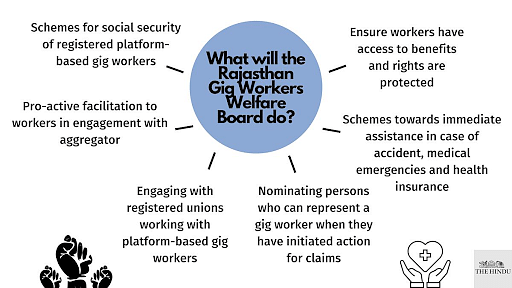
Concern Over the Bill
- Ambiguity of definition: The Bill does not clearly define gig workers and aggregators, and does not recognize the aggregator as an employer, affecting rights and obligations of both parties.
- Issues with regard to gig workers: The Bill does not follow the international best practices to determine whether a gig worker is an employee or an independent contractor such as ABC Test.
- Issues with gig workers’s database: The Bill proposes to create a permanent database of gig workers that does not reflect their actual engagement with platforms.
- This creates barriers for workers who work for multiple platforms or switch platforms.
- Concerns with social security provisions: The Bill does not specify what kind of social security schemes will be provided to gig workers, and leaves this decision to the welfare board.
- This results in inadequate and inconsistent social security coverage for gig workers.
ABC test is to determine whether a worker is an independent contractor or an employee
|
Read more on Gig Workers : {GS2 – Welfare Schemes – 2023/08/11} Gig Workers
{GS2 – MoF – Schemes – 2023/08/31} SWAMIH Scheme
- Context (HBL): The SWAMIH Scheme (Special Window for Affordable and Mid-Income Housing) is an initiative to provide funding for the completion of stalled housing projects.
- The scheme was launched in 2019 with the following objectives:
- To provide priority debt financing for the completion of stalled housing projects.
- To boost the growth of the real estate sector in India.
SWAMIH FUND
- The scheme is implemented through the SWAMIH Fund, which is a government-backed fund set up as a Category-II AIF debt fund registered with SEBI.
- The Fund is sponsored by the Ministry of Finance and is managed by SBICAP Ventures Ltd.
- The Fund has no precedent or comparable peer fund in India or global markets.
- The government has committed to infuse up to Rs. 10,000 crore in the fund.
- The maximum finance for any single project is Rs. 400 crore.

Eligibility Criteria for the Projects to Receive Funding from SWAMIH Fund
- Funding shall be provided to the projects that meet the following criteria:
- Stalled for lack of adequate funds
- Affordable and Middle-Income Category
- Net worth positive projects
- RERA registered
- Priority for projects very close to completion
{GS2 – MoSJE – Organisations – 2023/08/31} NSKFDC
- Context (PIB): The Ministry of Social Justice and Empowerment (MoJSE) and the National Safai Karamcharis Finance and Development Corporation (NSKFDC) signed a MoU.
- This partnership aims to enhance the socio-economic upliftment of Safai Karamcharis, Manual Scavengers, Waste Pickers, and their dependants.
National Safai Karamcharis Finance and Development Corporation (NSKFDC)
- It is a wholly-owned GoI undertaking under the MoSJE.
- It was set up in 1997 as a Company “Not for Profit” under the Companies Act, 1956.
- It is an apex corporation for the all-around socio-economic upliftment of the Safai Karamcharis, Scavengers, and their dependants throughout India.
- It does it function through various loan and non-loan based schemes.
- It is the implementing agency for National Action for Mechanised Sanitation Ecosystem (NAMASTE) scheme.
National Action Plan for Mechanised Sanitation Ecosystem (NAMASTE) Scheme
Benefits Under the Scheme
|
{GS3 – Envi – Laws – 2023/08/31} NGT
- Context (TH): The National Green Tribunal has directed the Border Roads Organisation (BRO) to plant at least 10,000 trees in Uttarakhand.
- BRO has felled hundreds of trees during the construction of a road in Chamoli district, Uttarakhand.
- As a result landslides have occurred in the ecologically fragile region.
- So, the NGT said that compensatory tree plantation must be carried out by the BRO and at least a part of the plantation must be done in a manner that will prevent landslides.
National Green Tribunal (NGT)
- NGT is established in 2012 under the National Green Tribunal Act (2010) for effective and expeditious disposal of cases relating to environmental protection and conservation of forests and other natural resources.
- It is mandated to dispose of the appeals within 6 months of the filing of appeals.
- It has five places of sittings; New Delhi is the principal place of sitting and Kolkata, Bhopal, Pune, and Chennai are the other four sittings.
- India is the 3rd country in the world to set up a specialised environmental tribunal after Australia and New Zealand.
Members of NGT
- The sanctioned strength of the tribunal is currently 10 expert members and 10 judicial members although the act allows for up to 20 of each.
- Every bench of tribunal must consist of at least 1 expert member & 1 judicial member.
- The Chairman of NGT is required to be a serving or retired Chief Justice of a High Court or a judge of the Supreme Court of India.
- The Chairman of the tribunal also serves as a judicial member.
Powers and Jurisdiction NGT
- NGT has original jurisdiction over all civil cases involving substantial question relating to the environment.
- It is a statutory adjudicatory body like Courts, so, apart from original jurisdiction it also has appellate jurisdiction.
- It is not bound by the procedure laid down under the Code of Civil Procedure 1908, but shall be guided by principles of ‘natural justice’.
- NGT’s decisions are executable as a decree of a civil court.
- An appeal against its decision can be made in the Supreme Court within 90 days.
- NGT deals with civil cases under the seven laws related to the environment. They are:
- The Water (Prevention and Control of Pollution) Act, 1974
- The Water (Prevention and Control of Pollution) Cess Act, 1977
- The Forest (Conservation) Act, 1980
- The Air (Prevention and Control of Pollution) Act, 1981
- The Environment (Protection) Act, 1986
- The Public Liability Insurance Act, 1991
- The Biological Diversity Act, 2002
Challenges in the Functioning of NGT
- NGT’s decisions can be challenged in High Courts under Article 226 (power of High Courts to issue certain writs), claiming that High Court is a constitutional body while NGT is a statutory body. Though, according to the NGT Act, NGT’s decision can be challenged only before the Supreme Court.
- Decisions of NGT are criticised and challenged are criticised as being against economic growth and development.
- There is high pendency of cases (though cases before NGT should be disposed of within 6 months) due to a lack of human and financial resources and the limited number of regional benches.
- NGT has no jurisdiction in matters relating to:
- Wildlife (Protection) Act, 1972
- Indian Forest Act, 1927
- Various laws enacted by states relating to forests, tree preservation etc.
- Absence of any formula for determining the compensation.
Border Roads Organisation (BRO)
- BRO is a statutory body under the Ministry of Defence established in 1960.
- It is a road construction executive force in India that provides support to Indian Armed Forces.
- BRO develops and maintains (including snow clearance) road networks in India’s border areas and friendly neighbouring countries.
- To ensure expeditious execution of projects, the GoI set up the Border Roads Development Board (BRDB) with the Prime Minister as Chairman and the Defence Minister as Deputy Chairman.
For detailed information National Green Tribunal > PMF IAS Environment Second Edition
{GS3 – MoHUA – Laws – 2023/08/31} Report on Real Estate Projects
- Context (IE I IE): A Committee headed by former NITI Aayog CEO Amitabh Kant was formed to suggest measures to revive stalled real estate projects.
- The committee submitted its report to the Ministry of Housing and Urban Affairs in August 2023.
- The report identified the lack of financial viability as the main cause behind stressed projects.
Amitabh Kant Committee’s Key Suggestions
Compulsory Registration Under Real Estate (Regulation and Development) Act, 2016
- The committee emphasized the implementation of the Real Estate (Regulation and Development) Act, 2016 (RERA).
- The RERA requires that all projects with a land area of more than 500 m2 or more than eight apartments to be built are registered with the respective state RERA.
- This would ensure more transparency.

Revival Plan for Stalled Projects
- State governments should create a revival plan for the stalled projects.
- The developers who opt for the plan would have to finish the projects within three years.
- This includes a “Zero Period” of two years starting from 2020 when the COVID-19 pandemic began, during which the authorities would not charge any interest or penalties on the developers.
- Developers would be allowed to bring in a “co-developer” to complete the work.
- The committee proposed a “partial surrender policy”, in which developers can return some of the unused lands to the authority and get a waiver on the dues for that land.
Special Window for Affordable and Mid-Income Housing (SWAMIH) Fund
- The report said the MoHUA should design a detailed scheme for using the SWAMIH Fund to proactively finance stalled projects and send it to the Finance Ministry.
- The criteria of minimum Internal Rate of Return and first charge in the fund should be revised.
Implementation
- Land is a state subject and most recommendations of the committee fall within the purview of the respective state governments.
- UP has started to implement the rehabilitation package for the projects in NOIDA and Greater Noida.
{Prelims – Cyber Security – 2023/08/31} Spamouflage
- Context (TH): Meta, which owns Facebook, has removed thousands of Facebook accounts that were part of a pro-China online propaganda campaign called “Spamouflage”.
- Spamouflage was a large-scale Chinese spam operation that posted positive messages about China and negative messages about the US, Western foreign policies, and critics of China.
Doppleganger
|
{Prelims – World PIN – Africa – 2023/08/31} Gabon
- Context (BBC): The Gabon army seized power from President Ali Bongo.
- The military takeover in Gabon is the eighth in West and Central Africa since 2020.
- Military officers have also seized power in Niger, Mali, Guinea, Burkina Faso, and Chad.
Gabon
- Gabon is an oil-rich country on the west coast of Central Africa, with a small population.
- It joined the Commonwealth in 2022.
- It is located on the equator and is bordered by:
- Equatorial Guinea to the northwest
- Cameroon to the north
- Republic of the Congo on the east and south
- Gulf of Guinea to the west
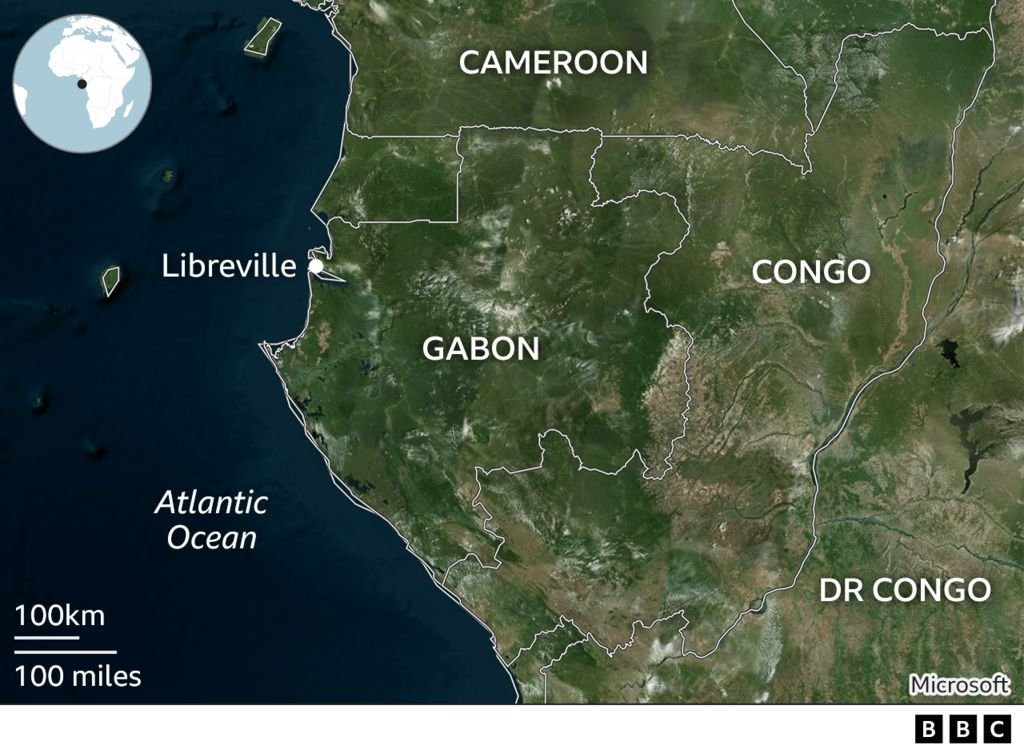




![PMF IAS Environment for UPSC 2022-23 [paperback] PMF IAS [Nov 30, 2021]…](https://pmfias.b-cdn.net/wp-content/uploads/2024/04/pmfiasenvironmentforupsc2022-23paperbackpmfiasnov302021.jpg)



